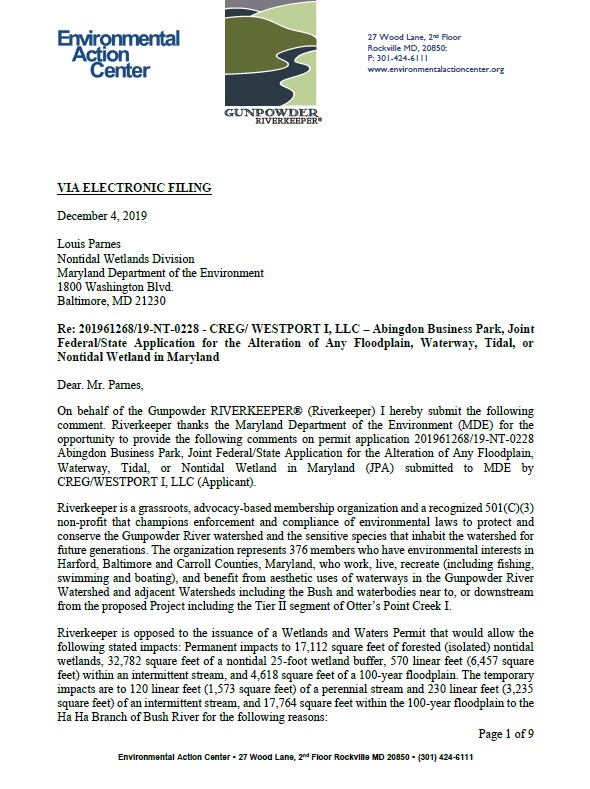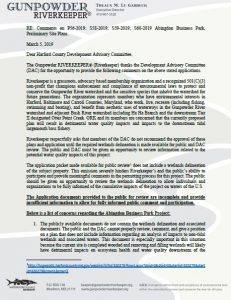On June 21, 2016, Harford County Council passed a state required financial assurance plan which described how the County will accomplish the stormwater runoff control required by Maryland Department of the Environment (MDE) by the end of the County’s pollution permit, also called the EPA Clean Water Act Permit. This requirement is part of the larger program to clean up the Chesapeake Bay and its tributaries (e.g. Winters Run, Broad Creek, Bush River) by 2025. The reduction of stormwater runoff pollution is important because it is the only source of water pollution that is increasing.
Harford’s financial assurance plan clearly stated that the County intended to remediate only half of the stormwater pollution it is required to stop. The reason for this shortfall was described as inadequate finances. Finances are inadequate because the County Executive and County Council eliminated the stormwater management fee, without identifying an adequate funding source to replace it. In addition, the County is appealing the terms of its current permit so that it does not have to comply with current and future pollution control requirements.
The County has submitted a financial assurance plan that may be unacceptable and misleading about what will be accomplished with available funding. EPA administrators have already stated that EPA will not accept unused sewage treatment capacity as credit for stormwater runoff control as proposed by the County. More important, such a claim for credit does not reduce pollution in any way and especially not pollution caused by stormwater runoff.
The County also proposes to obtain pollution control credit for connecting septic systems to sewers or by converting septic to the best available technology. This exchange of pollution control seems reasonable and will probably result in a reduction of nutrient pollution, but it does nothing to reduce the siltation of our waters or reduce the risks of flood damage from stormwater runoff. An example of a much better trade is to assist farmers in planting cover crops and/or stream side wooded buffers in exchange for urban stormwater management where urban management is not feasible. Cover crops and wooded stream side buffers reduce erosion, sedimentation, nutrient pollution and increase stormwater infiltration, thus reducing the risk of flooding. But of course, this kind of action requires funding.
Finally, the financial assurance plan claims that grants will provide some of the funding needed. If the granting agency is the federal government and it considers septic system – sewer connections and unused sewage treatment capacity claims for pollution reduction credit as a reallocation of funds, rather than funding of genuine pollution control, additional grants are very unlikely.
The financial assurance plan seems to be part of a pattern of avoiding stormwater runoff control. The plan clearly states that the County does not have the finances necessary to reduce sedimentation and nutrient pollution required by state and federal plans. The County also acknowledges this situation in the new Master Plan – Harford Next Water Resource Element Plan – Appendix 2. The County has budgeted a hundred thousand dollars to join some other counties to litigate the requirements of the state and federal water pollution control plans rather than develop a replacement for the funding program it completely canceled. In addition, a recent survey revealed that developers complied with the County’s Erosion and Sedimentation Act only 34% of the time, and the County has presented no plans to increase the compliance rate either through education or enforcement.
So it appears that Harford County is unwilling to develop adequate funding sources for needed programs that result in significant water quality improvement. For example, County administrators used and are still using the term “Rain Tax” to mislead the public about the problem and the need for solutions. Rain is an uncontrollable natural process – but hot, dirty, destructive runoff from heavy rain is created by people and their impervious roads, parking lots, and buildings. Government must participate in educating our citizens about the problem and take the lead in developing fair, equitable and effective stormwater control programs.
The stormwater runoff control fee had many problems and needed revision or replacement instead of total elimination. Corrective efforts, so far, have been grossly inadequate as evidenced by the financial assurance plan and the County Master Plan. Unless the current County Administration and Council believe that government, landowners and businesses have a right to pollute and to flood downstream properties, we must accept that we have an obligation to change our ways and fix these man-made problems.




